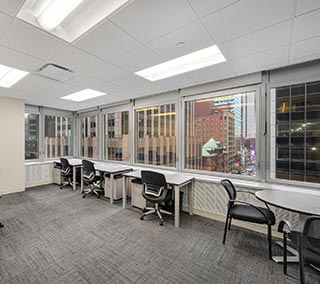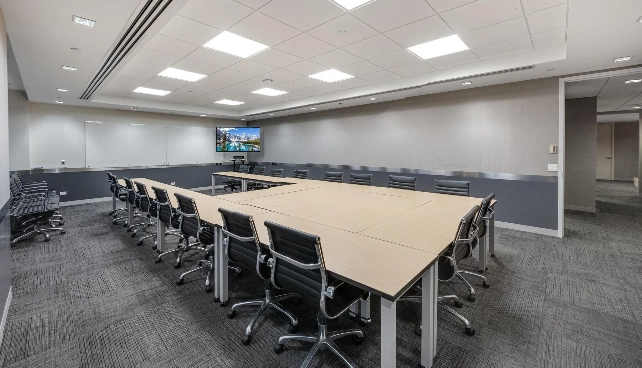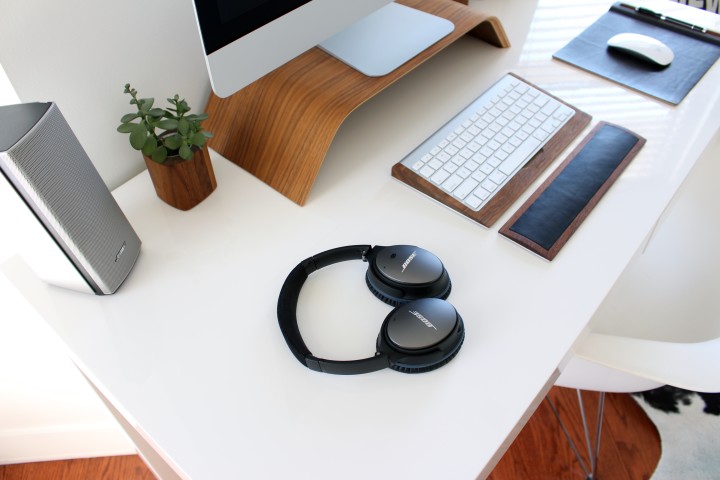You can reduce noise in a shared office by using noise-canceling headphones, white noise machines, acoustic panels and carpeted flooring. You can also encourage mutual respect among shared office workers to reduce volume levels and keep distractions to a minimum.
Why Is It Important to Reduce Noise in a Shared Office Environment?
It’s important to reduce noise in a shared office environment because noisy workspaces can lead to distractions that reduce productivity. Talking, music, ringing phones and computer noises can all cause a loss of focus for other people in a shared workspace.
On top of being distracting, noises in a shared workspace can create tension among workers and lead to interpersonal issues that hurt productivity. When individuals don’t work well together because of tension in the office, teams can suffer as well. By reducing noise levels and distractions, workers tend to get along with one another, and teams are more productive.
Understanding the Sources of Unwanted Noise in the Office
Noise in a shared office environment can come from sources like people talking and phone conversations, radios and music players, nearby group discussions, computer keyboards and digital system sounds, ambient noise and general foot traffic around an open workspace.
It’s also worth noting that noise travels and bounces off of reflective surfaces. This means that even sounds from across a shared office space may be amplified or sound closer than they are because sound waves bounce off of hard flooring, metal office furniture and walls and ceilings.
Ambient sounds from things like an office HVAC system may also be a problem in a shared office. These sounds generally can’t be avoided, but they can be mitigated. The same is true for ambient sounds that come from electronic equipment like computers or monitors. The light buzzing sound that is emitted from electronic equipment may not be a problem when you only have one device running, but multiple devices running in a shared office setting can create a lot of noise.
Identifying the Types of Sounds Generated by People and Equipment
There’s no way to completely eliminate all sounds in a shared office environment simply because people and office equipment naturally generate noise, but it can be helpful to identify the source of sounds. Electronic equipment generates a high-pitched whine while someone walking by a desk will cause some level of noise through footsteps. Office equipment like computer keyboards can also create noise.
These noises generally aren’t distracting in and of themselves, but they become distracting when an office space is shared by a large group of people. The combined sounds of many people typing on keyboards, coughing or rustling papers across an entire shared office can make small noises turn into distracting sounds.
External Noise Sources
Aside from noises inside a shared office space, external sounds from outside the building can cause distractions as well. Automobiles, airplanes, car horns, sirens and other traffic noises outside a shared office space can be distracting and lead to a loss of focus and productivity.
These sounds are particularly challenging if a shared office space is at ground level and is located near a major roadway or transportation hub. Many shared office spaces in urban centers face these problems, and shared workspaces that have a lot of windows can also have a hard time tamping down external noise sources.
Understanding How Sound Propagates Throughout an Office Space
Sounds propagate through an office space in different ways. Some sounds are directional, meaning sound waves generated by noise come from a specific source. Others are reflective sounds, meaning they generate sound waves that bounce off of reflective hard surfaces.
Reflective sounds can be challenging to deal with because they bounce around. If a shared office space has hard floors or metal office furniture, these surfaces tend to amplify and pass along sound waves, causing some distracting noises to travel across long distances in a shared office space. The height of ceilings and the width and depth of shared office spaces can also play a role in sound reverberation.
Strategies for Reducing Noise in a Shared Office Space
There are a number of strategies that can be used to reduce noise in a shared office space, including acoustic panels and mineral wool insulation, white noise machines, noise-canceling headphones or earplugs and sound-deadening partitions.
Acoustic Panels and Mineral Wool Insulation
Acoustic panels can be strategically set up around a shared office to reduce sound reflections. These panels, along with mineral wool insulation, are designed to trap sound waves and stop them from reflecting off surfaces, thereby reducing the spread of noise. Acoustic panels can be attached to walls in a shared office, but they can also be used to create partitions or cubicles.
White Noise Machines and Background Music
White noise machines and similar types of background sounds can be used to shut out ambient noises in a shared office. If you use a white noise machine or some type of background music, take care not to let the noise generated from these sources become distractions themselves. If you are listening to music on open-back headphones, pay attention to the volume level as even headphones can leak sound and distract nearby workers in quiet areas.
Open-Plan Offices and Designated Quiet Spaces
Open-plan office spaces are common in a shared office environment, but these types of designs can make it difficult to cut down on distracting sounds. To combat unwanted noise and distractions, some open-plan shared offices will have designated quiet zones where noise is expected to be kept to a minimum.
Use of Sound Privacy Solutions, Such as Partitions or Cubicles
The use of partitions and cubicles can greatly impact the spread of distracting noises in a shared office. Partitions and cubicles that utilize acoustic paneling or mineral wool insulation can further stop sound waves before they have a chance to cause distractions.
Investing in Quality Headphones and Earplugs
High-quality noise-canceling headphones use advanced technology to reduce ambient noise. If you don’t want to invest in quality headphones, standard earplugs can also reduce ambient sounds and stop distractions.
Utilizing Indoor Plants to Help Absorb Unwanted Sounds
Indoor plants set up around a shared workspace can sometimes lessen distracting noises. Large, leafy plants block reflective sound waves from bouncing around shared offices, but they will not block sound entirely.
Keeping Work Areas Tidy to Prevent Unnecessary Noises
A tidy workspace can also contribute to creating a quiet workspace. Cluttered work areas can cause sounds like paper rustling and the opening and closing of drawers to find supplies. Keeping a workspace neat means workers can find what they need quickly without a lot of shuffling around which can lead to noise.
Frequently Asked Questions
Below are some frequently asked questions about reducing noise and distractions in a shared office:
How do I reduce noise in a shared home office
You can reduce noise in a shared home office by wearing noise-canceling headphones or by turning on a white noise machine. You can also institute a quiet-time policy that sets aside specific work hours for minimal noise.
How do you reduce noise in an office
You can reduce noise in an office by setting up partitions that use acoustic paneling or mineral wool insulation. Partitions can be combined to create cubicles, but noise can still enter over the top of these partitions depending on the height. High-quality headphones or earplugs can further stop office noise that leads to distractions.
What is the most effective way to reduce noise in the workplace
The most effective way to reduce noise in the workplace is to eliminate sounds at the source. This can be done by instituting a quiet-office policy during certain work hours. People should be encouraged to turn off or silence electronic devices and ambient noise can be quieted using noise-canceling headphones.
What is the most effective way of reducing unwanted noise in a space
The most effective way of reducing unwanted noise in a space is to identify the source of the noise and mitigate it directly. This may be done by asking someone to hold conversations in a different space, but the use of earplugs or similar sound-deadening tools can also be helpful.
What can be used to reduce noise
Noise can be reduced by setting up acoustic paneling around hard surfaces that reflect sound. Noise can further be reduced by wearing headphones that employ active noise-canceling technology.
Reducing noise in open plan offices
Reducing noise in open plan offices usually requires different areas of a workspace to be designated as quiet zones. This keeps work areas quieter while still allowing workers to have conversations in designated areas without distracting others.
Strategies to reduce noise in the workplace
There are a number of strategies to reduce noise in the workplace, including setting up insulated partitions that block sound waves, instituting quiet-time policies, keeping workspaces free of clutter and using white noise machines. Different strategies can be used individually or in combination with one another depending on the type of noise you’re dealing with.
How to block out noisy coworkers
Blocking out noisy coworkers can be difficult if you work in close proximity, but headphones that use active noise canceling work well to drown out sounds like light talking and computer keyboards. You can also try using a white noise machine or creating a partition that uses sound-deadening acoustic foam or panels.
How to reduce noise through walls
You can reduce noise through walls by hanging artwork with thick frames on the affected areas. The artwork and frames may absorb sound waves before they have a chance to spread around your workspace. Headphones or earplugs can also be worn to reduce the effect of noisy neighbors next door.
Looking for an office in the city? Corporate Suites offers furnished office spaces, virtual offices & conference rooms in several prestigious locations across New York City.






